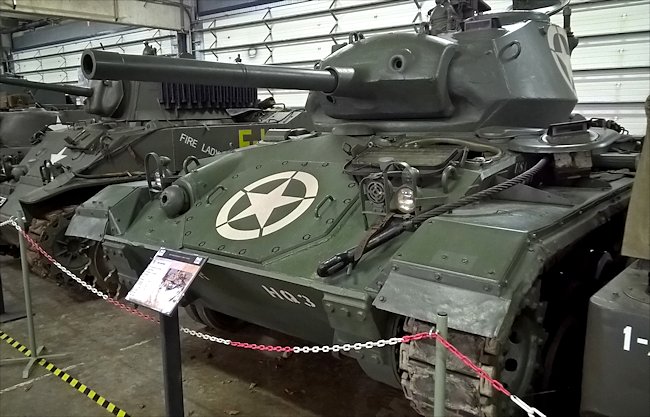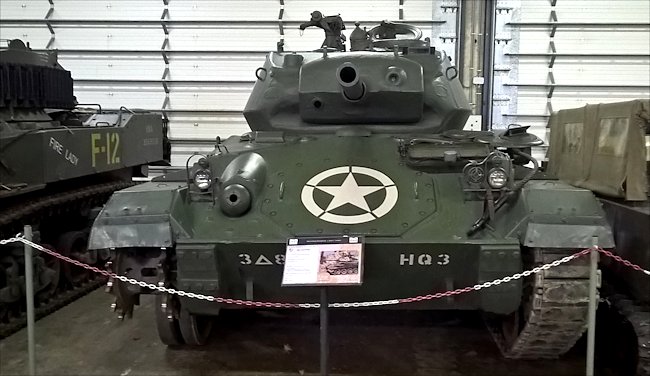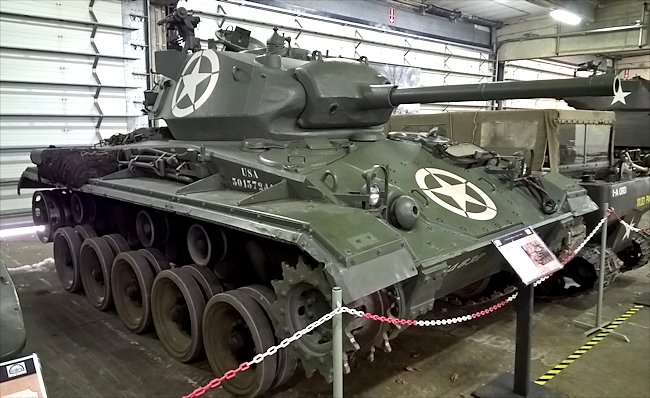M24 Chaffee Light Tank
M24 Chaffee Light Tanks saw action in the WW2 Battle of the Bulge. This surviving American tank is kept at the Bastogne Barracks in Belgium.

This restored M24 Chaffee Light Tank is exhibited at the Bastogne Barracks in Belgium. The metal plate on the front left wing mudguard is the jacking plate.
Location
The Bastogne Barracks can be found at 40 Rue de la Roche (N834) in Bastogne just north west of the city centre. They open at 10am and close at 4pm. You really need to get there by 2pm as there is a lot to see. It is an operational military camp with a tank restoration centre attached. You have to wait to go on a guided tour. You cannot wander around on your own. The only day it is closed is Monday. Many of the tanks have been restored to running condition. Have a look at their Facebook page for information about new events.

This restored M24 Chaffee Light Tank is exhibited at the Bastogne Barracks in Belgium.
Specifications
The M24 Chaffee light tank was a replacement for the M5 Stuart. It was powered by two Cadillac series 44T24 8 cylinder engines that produced 110 hp each. This gave the tank a top road speed of 35 mph (56 km/h) and an off road speed of 25 mph (40 km/h). It had an operational range of around 100 miles (161 km) before the crew needed to refuel the Chaffee. Although it was a light tank it still had a crew of five: commander, gunner, driver, loader, co-driver/machine-gunner/radio operator. It was produced from 1944 to August 1945 and 4,731 were made.
For a light tank it had a powerful main gun. It was fitted with a 75mm M6 L/39 gun. The Chaffee was armed with three machine guns. A .30-60 Browning M1919A4 machine gun was installed in the hull. Another was fitted next to the main gun in the turret. A .50cal Browning M2HB machine gun was attached to an external mount on the back of the turret. The tank weighed 18.4 tonnes. Production started in 1944 and ended in August 1945 after 4,731 had been produced. They were designed to replace the aging M5 Stuart Light tanks. The first M24 Chaffee arrived in Europe in November 1944 just in time for the Ardennes Offensive.

This restored M24 Chaffee Light Tank is exhibited at the Bastogne Barracks in Belgium.
Belgium Army Cold War M24 Chaffee tanks
At the end of World War Two the Belgium army were issued with 156 M24 Chaffee tanks to be used operationally as light reconnaissance Cavalry tanks along side M4 Sherman 17pdr Firefly tanks, M10C Achillies 17pdr anti-tank self-propelled guns and later M47 Patton tanks. They were later replaced by the M41 Walker Bulldog. This is one of those Belgium Army Chaffees.
Development of the M24 Chaffee
Observation of the British experiences in the Western Desert fighting in 1942 when the 8th Army was using M3 Stuart light tanks, showed that a heavier weapon was desirable for future US light tanks.
A 75mm gun was fitted experimentally to a M8 HMC in place of the howitzer, and firing trials proved that it would be possible to develop a version of the M5 series light tank armed with the 75mm gun. Stowage space was severely restricted in the M5, however, more so with the fitting of a 75mm gun, and in addition the overall design of this vehicle was now dated and the armour thickness was inadequate.
In April 1943, therefore, following the demise of T 7 light/M7 medium programme (qv) the Ordnance Department, in conjunction with Cadillac (makers of the M5 series), began work on an entirely new light tank design which was to incorporate the best combinations of features from earlier designs with all lessons learned from previous experience.
The twin Cadillac engines and Hydra-matic transmission which had been so successful and trouble-free in the M5 series were retained and the good accessibility which had been a feature of the T 7 layout was adopted. A weight of 18 (short) tons was envisaged with an armour basis of only 25mm to save weight, but with all hull faces angled for optimum protection. Maximum turret armour was 37mm.
Vertical volute suspension was replaced by road wheels on torsion arms to give a smoother ride. First of two pilot models, designated T 24, was delivered in October 1943 and proved so successful that the Ordnance Department immediately authorised a production order for 1,000 vehicles which was later raised to 5 000. Cadillac and Massey-Harris undertook production, commencing March 1944 and these two plants between them produced 4,415 vehicles (including SP variants) by the war's end. In each case production supplanted M5 series vehicles.
The 75mm M6 gun was adapted from the heavy aircraft cannon used in the Mitchell bomber, and had a concentric recoil system which saved valuable turret space. The T 24 was standardised as the Light Tank M24 in May 1944. First deliveries of M24s were made to American tank battalions in late 1944, supplanting M5s, and the M24 came into increasing use in the closing months of the war, remaining as standard American light tank for many years afterwards.
Parallel to the need for a new light tank was the desire to produce a standard chassis as the basis of the so-called Light Combat Team — a complete series of tanks, SP guns, and special purpose tanks all based on one chassis so greatly simplifying maintenance and production. The many variants produced to meet this concept are given below. Each had identical engine, power train, and suspension to the M24.
In British Army Service a small number of M24s were supplied to Britain in 1945 and remained in service for a short time after the war. In British service the M24 was called Chaffee and this name was subsequently adopted in the U.S. Army.
Read more in these two tank books

